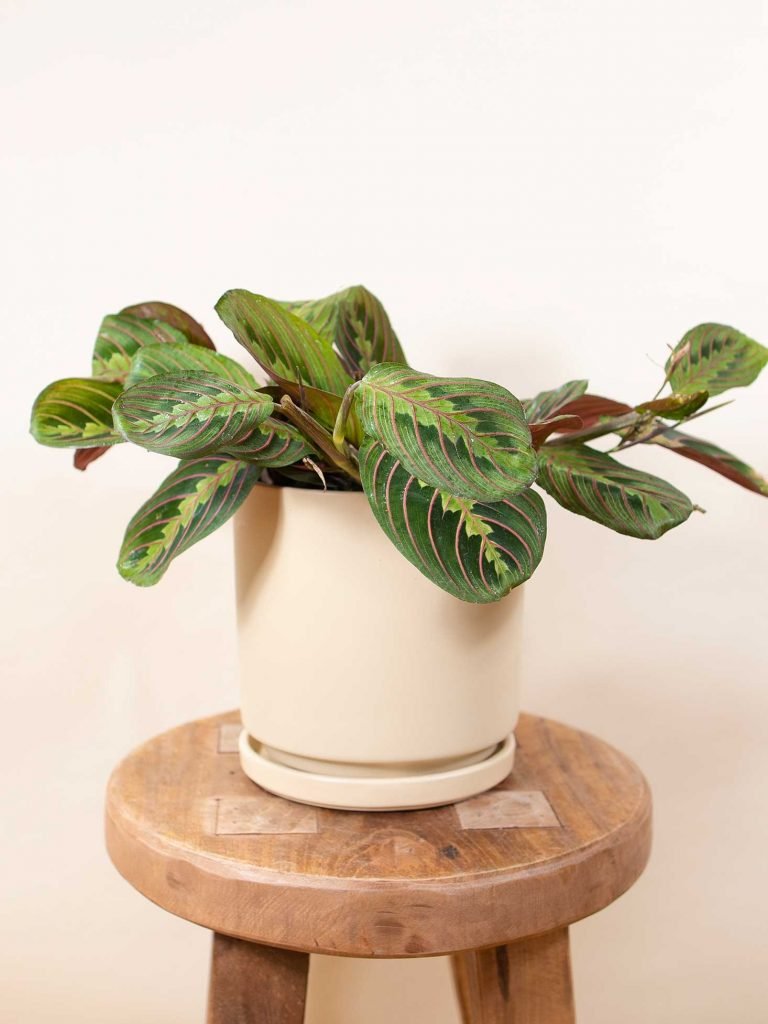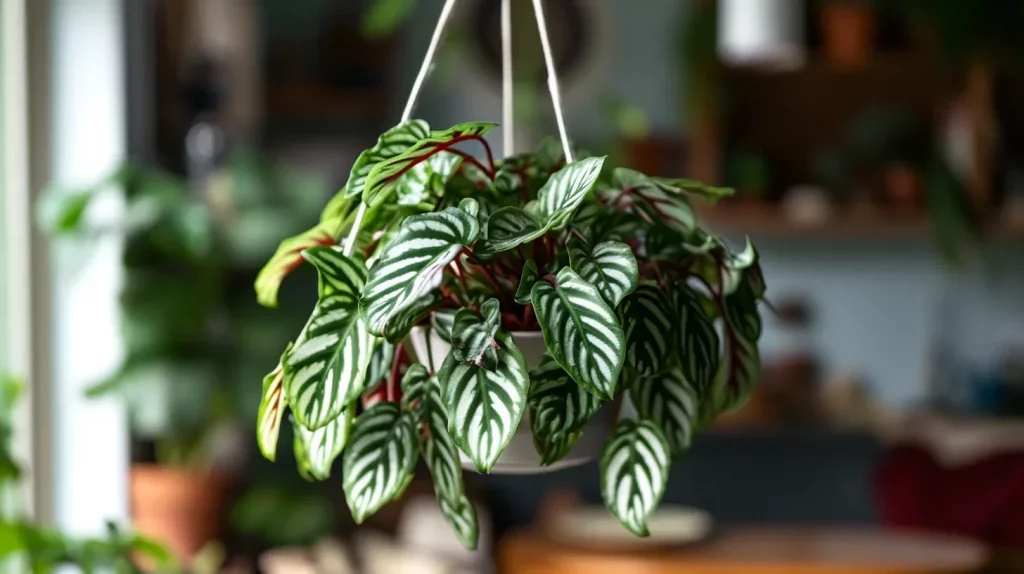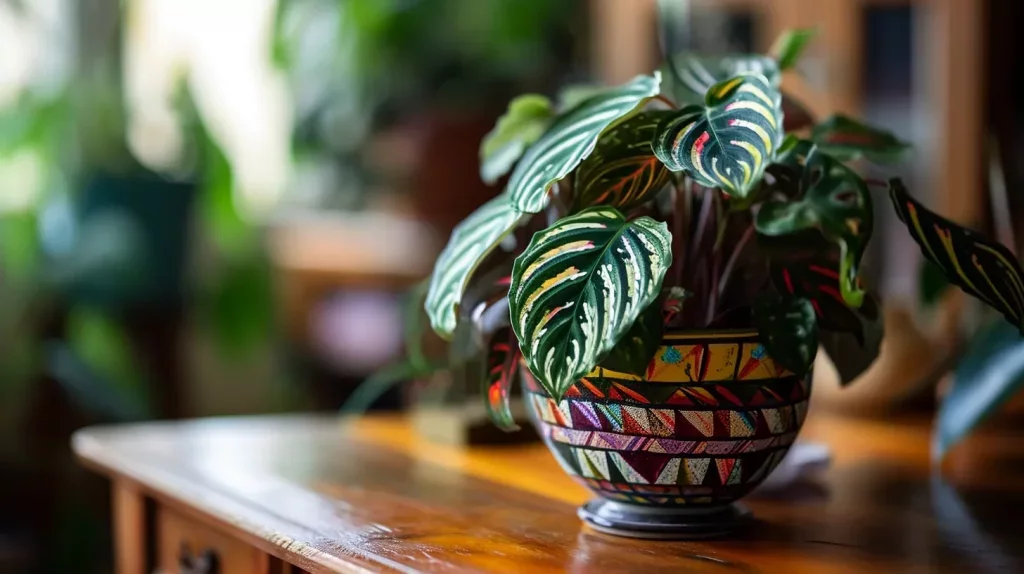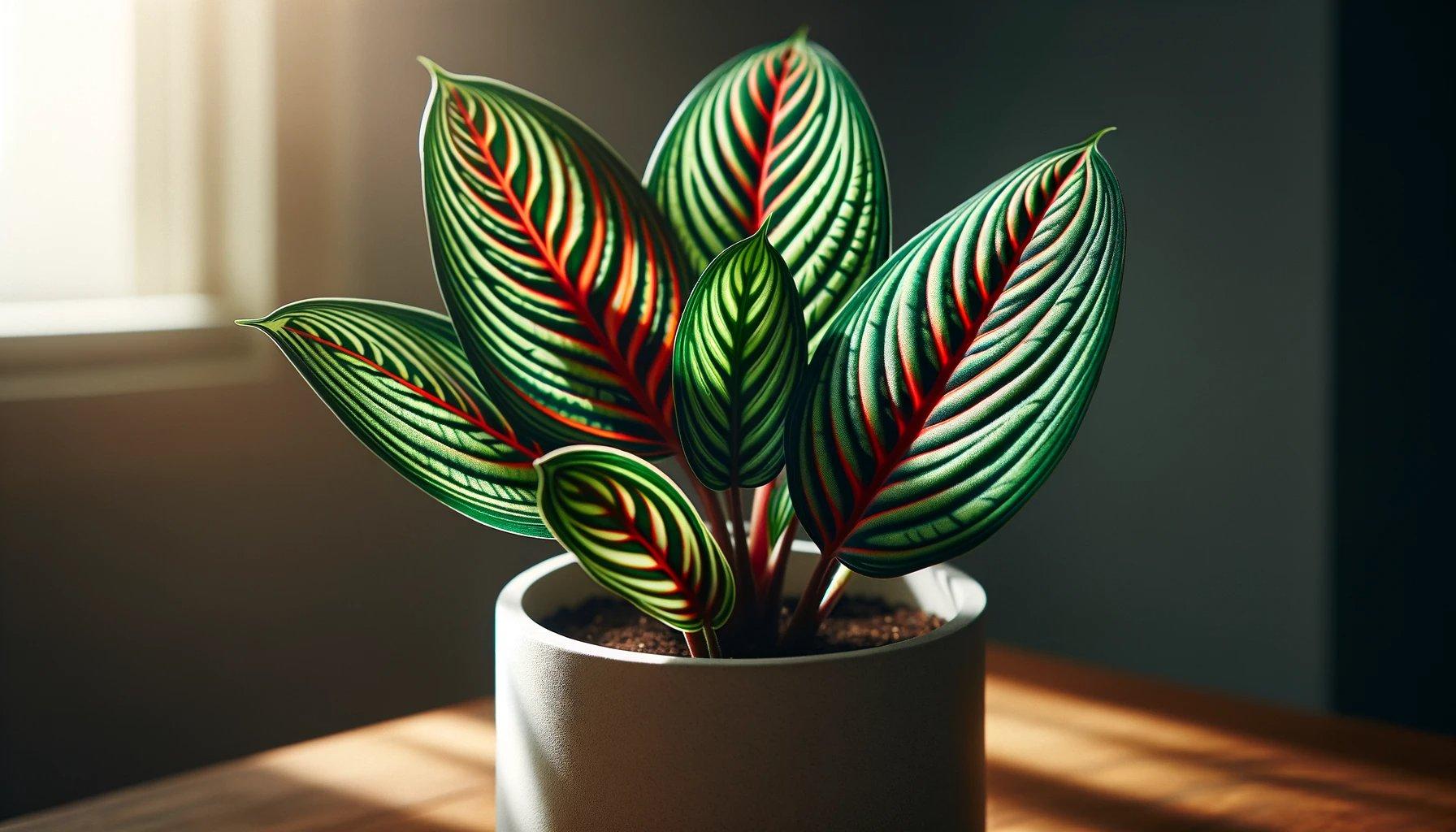Understanding the Prayer Plant (Maranta leuconeura)
Welcome to my comprehensive guide on caring for the marvelous Prayer Plant! 🌿 As a passionate plant enthusiast, I’ve had my fair share of experiences with these striking beauties. Their unique leaf movements and stunning patterns always bring a sense of wonder to any plant collection. In this guide, I’ll share my tips and insights on how to nurture your Prayer Plant to its full splendor. Let’s dive in!
The Prayer Plant, belonging to the Marantaceae family, is celebrated for its unique daily leaf movements, resembling praying hands and striking leaf patterns. Originating from the tropical rainforests of Brazil, Maranta leuconeura exhibits a natural rhythm, with its leaves lying flat during the day and folding upright at night, a phenomenon known as nyctinasty. This attribute, coupled with its vibrant leaf patterns, makes the Prayer Plant a captivating addition to any indoor plant collection.
Botanical Profile
| Feature | Details |
|---|---|
| Common Name | Prayer Plant |
| Nicknames | Maranta, Red Prayer Plant, Praying Hands |
| Botanical Name | Maranta leuconeura |
| Family | Marantaceae |
| Plant Type | Perennial, Houseplant |
| Leaf Color | Green with red veins and splotches |
| Mature Size | 1-2 feet tall and wide |
| Sun Exposure | Bright, indirect light |
| Bloom Time | Rarely blooms indoors |
| Flower Color | White or light purple (if it blooms) |
| Hardiness Zones | Typically grown as a houseplant |
| Native Area | Tropical rainforests of Brazil |

Types of Prayer Plants
Prayer Plants are a fascinating group of plants we’ll explore the various varieties of Prayer Plants, each with its distinctive charm. Understanding the differences between these varieties can help you choose the right one for your home or garden.
Maranta leuconeura var. erythroneura (Red Prayer Plant)
- Description: The Red Prayer Plant is perhaps the most iconic variety. It features striking green leaves with bright red veins and a herringbone pattern. The contrast between the red and green makes this variety a visually stunning choice for indoor plant enthusiasts.
Maranta leuconeura ‘Kerchoveana’
- Appearance: This variety, also known as Green Prayer Plant, has dark green leaves with lighter green patches on either side of the central vein. The leaves fold up at night, similar to hands in prayer, giving the plant its common name.
Maranta leuconeura ‘Lemon Lime’
- Features: The ‘Lemon Lime’ variety boasts beautiful, pale green leaves with dark green splotches and a hint of yellow or lime along the veins. The light-colored foliage offers a unique aesthetic compared to other varieties.
Maranta leuconeura ‘Massangeana’
- Characteristics: Also known as Black Prayer Plant, this variety has dark green leaves with silvery blotches along the midrib and white leaf undersides. It’s an elegant and somewhat less common variety.
By choosing the right variety and providing the appropriate care, you can enjoy the beauty and unique characteristics of these remarkable plants. Whether you’re drawn to the classic red veins of the erythroneura or the subtle elegance of the ‘Massangeana’, these plants bring a dynamic and vibrant presence to your space.
Prayer Plant Care Guide
Light
Proper lighting is crucial for the well-being of your Praying Hands Plant.
- Ideal Conditions: Maranta plants prefer bright, indirect light. They can thrive under the dappled light, which mimics the understory of tropical forests, their natural habitat.
- Avoid Direct Sunlight: Direct sunlight can be too harsh, leading to faded or scorched leaves.
- Placement Tips: A north or east-facing window is ideal. If placed in a south or west-facing window, ensure the plant is shielded by a sheer curtain to diffuse the light intensity.
Water
Watering practices significantly impact the health of Prayer Plants.
- Watering Schedule: Keep the soil consistently moist but not waterlogged. The top inch of the soil should be allowed to dry out slightly before re-watering.
- Quality of Water: Marantas can be sensitive to tap water chemicals. Use filtered or distilled water, or let tap water sit out overnight before using.
- Overwatering Caution: Overwatering can lead to root rot, a common issue with Prayer Plants. Ensure your pot has good drainage to avoid water accumulation at the roots.
Soil
Choosing the right soil mix is fundamental for Maranta plants.
- Soil Type: Use a well-draining potting mix rich in organic matter. A mix specifically formulated for tropical plants or a general-purpose potting soil amended with peat moss, perlite, or vermiculite is ideal.
- pH Level: These plants prefer slightly acidic to neutral soil pH.
Temperature and Humidity
Creating an environment with the right temperature and humidity is key for the Praying Hands Plant.
- Temperature Range: Maranta plants prefer warm temperatures, ideally between 60-80°F (15-27°C). Avoid exposure to sudden temperature changes or drafts.
- Humidity Requirements: These plants thrive in high humidity. In drier environments, use a humidifier or place the pot on a tray filled with pebbles and water to increase ambient moisture. Regular misting also helps.
Fertilizer
Fertilizing your Prayer Plant promotes healthy growth and vibrant foliage.
- Fertilizing Schedule: During the growing season (spring and summer), fertilize your Prayer Plant once a month with a diluted, balanced, water-soluble fertilizer.
- Winter Care: Reduce fertilizing in the winter months as the plant’s growth slows down.
- Signs of Over-Fertilization: Watch out for leaf burn or a crust of fertilizer on the soil surface, which indicates over-fertilization.
By following these detailed care instructions, you ensure that your Prayer Plant not only survives but thrives, bringing its unique beauty and charm to your home.

Growing Your Red Prayer Plant
How to Propagate
Propagation is an essential aspect of care for Prayer Plant, allowing you to expand your collection or share this wonderful plant with friends.
- Division Method:
- Timing: The best time to propagate is in the spring, which is the beginning of the plant’s active growth period.
- Process: Carefully remove the plant from its pot and identify natural divisions in the root system. Gently separate the roots, ensuring each new section has a fair amount of roots and leaves.
- Planting: Pot each division in a well-draining soil mix, similar to what the parent plant was growing in. Water the new plants and keep them in indirect light as they establish.
- Leaf Cuttings:
- While less common, you can also propagate Maranta plants from leaf cuttings. Cut a healthy leaf with a portion of the stem attached and place it in water or moist soil until roots develop. This method requires patience, as it can take several weeks for new roots to form.
Potting and Repotting
The right potting approach can significantly impact the health and growth of your plant.
- Potting Mix: Use a light, airy potting mix that drains well. A mixture of peat, pine bark, and coarse sand or perlite is ideal for providing the necessary aeration and drainage.
- Repotting Frequency: Prayer Plants typically need to be repotted every 1-2 years. This refreshes the soil and provides room for growth.
- Repotting Steps:
- Choose the Right Pot: Select a pot that is slightly larger than the current one. Ensure it has drainage holes.
- Transplanting: Gently remove the plant from the old pot, shake off excess soil, and place it in the new pot. Fill in around the plant with fresh potting mix and water thoroughly.
Pruning
Pruning is an important aspect of maintaining the beauty and health of your plant.
- When to Prune: The best time to prune is in the spring or early summer when the plant is actively growing.
- Pruning Process:
- Removing Dead or Yellow Leaves: Regularly remove any dead or yellowing leaves to encourage healthy growth and improve the plant’s appearance.
- Shaping the Plant: If your Prayer Plant is getting too leggy or you wish to encourage fuller growth, prune it back to the desired shape. Always use clean, sharp scissors or pruning shears.
- Aftercare: After pruning, provide your plant with adequate water and light to encourage new growth.
Prayer Plant Pests and Plant Diseases: Solutions for Common Issues
Tackling Common Pests
Prayer Plants can attract certain pests. Here’s how to deal with them:
- Spider Mites: These tiny pests can cause leaves to yellow. Boost humidity around your plant, as spider mites dislike moist environments. Detect an infestation? Use insecticidal soap or neem oil for a quick remedy.
- Mealybugs: Look for cottony spots on the leaves and stems. Remove these pests with a cotton swab dipped in alcohol and apply insecticidal soap to prevent future attacks.
- Fungus Gnats: These thrive in wet soil. Let the soil dry out a bit more between waterings to discourage them.
Preventing and Treating Plant Diseases
Even robust Prayer Plants can succumb to diseases. Here’s what to watch for:
- Root Rot: Often a result of overwatering. Make sure your plant’s soil drains well and adjust your watering schedule to allow the soil to dry slightly between waterings.
- Leaf Spot Disease: This appears as discolored spots on leaves. Improve air circulation around your plant and water at the soil level to avoid wetting the leaves.
Common Plant Issues and How to Fix Them
- Yellow Leaves: This could be due to overwatering, too much direct sunlight, or pests. Check the plant’s environment and adjust your care accordingly.
- Drooping Leaves: This could indicate underwatering or low humidity. Ensure your plant gets enough water, and consider increasing humidity with regular misting.
- Brown Leaf Tips: A sign of dry air or under-watering. Prayer Plants enjoy humid conditions. Try misting your plant more often or use a humidity tray.
| Pros (+) | Cons (-) |
|---|---|
| ✅ Easy to Care For<br>Prayer Plants are relatively low-maintenance and adaptable to indoor conditions. | ❌ Sensitive to Water Quality<br>They can be sensitive to chemicals in tap water, preferring distilled or rainwater. |
| ✅ Non-Toxic to Pets<br>Safe for your furry friends. 🐶🐱 | ❌ Requires High Humidity<br>May need extra humidity, which can be a challenge in dryer climates or homes. |
| ✅ Visually Stunning<br>Unique leaf patterns and movements add a dynamic beauty to your space. 🌿 | ❌ Prone to Pests<br>Can attract pests like spider mites if not cared for properly. |
| ✅ Promotes Well-being<br>Having plants indoors can improve mood and air quality. 🌬️🍃 | ❌ Sensitive to Temperature<br>Dislikes cold drafts and sudden temperature changes. |
| ✅ Propagation is Easy<br>Simple to propagate and share with friends. 🌱👯♂️ | ❌ Slow Growing<br>Patience is needed as they are not the fastest growers. |
I hope you found this guide helpful and inspiring! If you have any questions or want to share your own Prayer Plant stories, feel free to drop a comment below. Let’s keep growing together! 🌱💚
For more detailed information about Prayer Plants, their history, and varieties, check out this comprehensive article on Wikipedia.

FAQ: Everything You Need to Know
What is Special About a Prayer Plant?
Prayer Plants are notable for their distinct leaf movements – their leaves lie flat during the day and fold up like hands in prayer at night. This movement is termed nyctinasty and is thought to be a way for the plant to conserve moisture and optimize light absorption. Additionally, their leaves often feature beautiful variegation, making them attractive as indoor plants.
Is a Prayer Plant Indoor or Outdoor?
Prayer Plants are primarily indoor plants, especially in temperate climates. They thrive in conditions found in most homes, preferring indirect sunlight and higher humidity levels. While they can be placed outdoors in summer in some regions, they should be protected from direct sunlight and harsh conditions.
How Long Do Prayer Plants Live?
With proper care, Prayer Plants can live for many years. They are perennials and can continue to thrive for five years or more, given the right conditions. Regular care and repotting can help extend their lifespan.
What Does a Prayer Plant Symbolize?
In some cultures, the Prayer Plant symbolizes gratitude due to its nightly prayer-like leaf movements. It’s often associated with expressions of faith and has a certain spiritual significance for many.
Do Prayer Plants Like to be Hung?
Prayer Plants can be grown in hanging baskets, where their trailing foliage can create an attractive display. They adapt well to both hanging and standing pots, making them versatile for various interior design settings.
Where is the Best Place to Put a Prayer Plant?
The best spot for a Prayer Plant is somewhere with bright, indirect light. A spot near a north or east-facing window or a little further back from a south or west-facing window is ideal. Ensure the plant is not exposed to direct sunlight, which can scorch its leaves.
Do Prayer Plants Get Big?
Some varieties of Prayer Plants can grow quite large, with leaves that extend up to a foot in length. However, they are generally considered moderate in size, making them suitable for most indoor spaces.
Do Prayer Plants Multiply?
Prayer Plants can multiply through root division. They occasionally produce offshoots, which can be separated and potted individually to propagate new plants.
Is Prayer Plant Easy to Take Care of?
Prayer Plants are relatively easy to care for, making them a great choice for beginners and experienced gardeners alike. They require consistent moisture, high humidity, and indirect light to thrive. Avoid overwatering, as this can lead to root rot.

